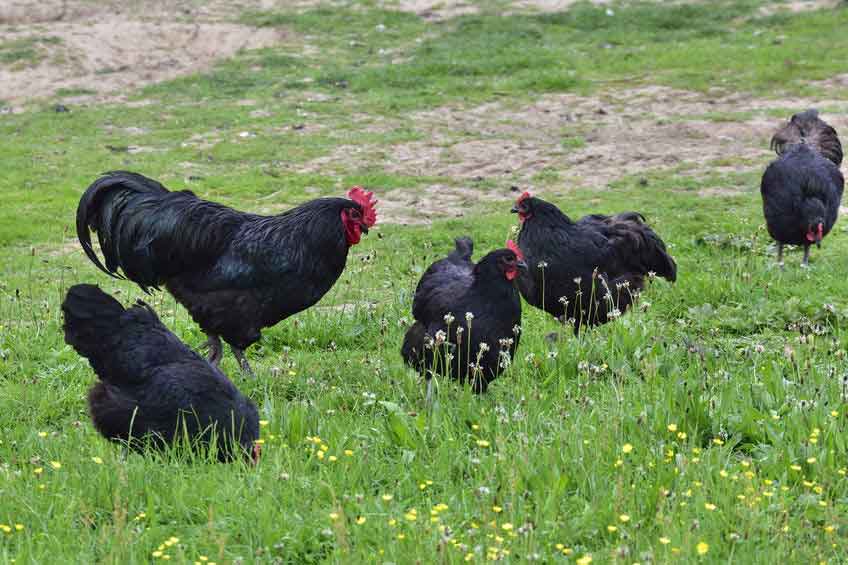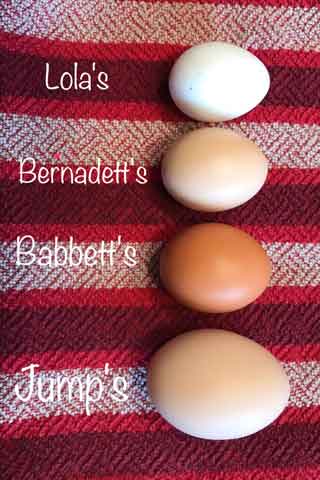Have you ever wondered, why are chicken eggs different colors? Chicken eggs come in a myriad of colors including brown, cream, white, green, blue, pink, gray and tinted. Many people have a preference for one particular egg color, such as brown. The common thought is that brown eggs taste better and are healthier than any other color of egg. Many others will think exactly the same about white eggs.
So, does the color of the egg mean anything at all? Is one color egg better than another? The answer is quite simply, no. The truth is that no singular colored egg is healthier for you or better for you than any other color. All colors are equal in the egg world. The color of the egg has no bearing on the eggs taste or how healthy it is. There are no major differences in the eggs from different breeds of chicken other than their appearance.
All Eggs Start Off White
So can we learn anything from the color of an eggshell? It can tell us which breed of chicken it came from and the color pigment gene the bird possesses. Egg color is determined solely by the breed of chicken that laid it. It is a genetic trait of each specific breed.
For example, Orpingtons, Rhode Island Reds and Plymouth Rock’s will lay eggs that are varying shades of brown. Leghorns will lay white eggs and Ameraucanas will lay blue eggs. Chickens that lay olive colored eggs are a result of a pairing between a blue egg laying bird and a brown egg laying bird.
However, no matter what breed of chicken you have, all chicken eggs, start off white. They may end up olive green, dark brown, light brown, cream, pinkish or blue, but they will all have started off white.
Colored and Tinted Eggs
The breeds of chicken that produce colored or tinted eggs each produce a certain color pigment. It is secreted by the hen and is painted onto the egg as it passes through the hen’s oviduct. The oviduct is a tunnel-like passage the egg moves through before reaching the outside world.
How dark the color is depends on how long the egg stays in this part of the oviduct for and how much color pigment each individual bird produces. Some will produce more pigment than others. Those that do not produce a large amount of pigment will produce paler colored eggs than those who produce a lot of pigment whose eggs will be darker in color.
Which Chicken Breeds Make White Eggs?
Several breeds of chicken carry no pigment gene at all and therefore lay white eggs. However, if they go for a long period of time without laying their eggs can change color and become slightly tinted or very pale brown in color.
Chickens that lay brown eggs have a brown pigment gene called protoporphyrin. These breeds include the Australorp, Wyandotte, Orpington and Cochin. Protoporphyrin is a derivative of blood and hemoglobin. The laying process for a single egg takes about 26 hours. The brown pigment is added on to the egg during the last 4 to 6 hours of this process.

However, only the outside of the shell is colored. The inside of a brown egg remains white in color and not brown. A small amount of pigment over the egg’s surface will produce a light beige or tan color. Whereas a lot of pigment will produce an egg that is a rich chocolate brown color. However, if you pair a breed that produces a light brown egg to one that lays a very dark brown egg the result will usually be an egg that is a medium brown color that falls somewhere between that of the parent birds eggs.
Genetics Play a Role
Chickens such as the Ameraucana, Cream Legbar and Araucana possess a dominant gene. It’s called oocyanin as well as biliverdin and, as a result of this, produce blue eggs. Unlike the brown pigment which is painted on towards the end of the egg-laying process, the blue pigment is added early on. As a consequence of this, the oocyanin gene penetrates through the egg shell. The result is that both the inside and the outside of the shell are the same color blue.
Pigmentation
Green and olive colored eggs are the result of mating a breed that lays brown eggs and a breed that lays blue eggs so that the egg contains both the brown gene and the blue gene. The brown color is laid on top of a blue eggshell which results in the egg being a green color. The darker the brown pigment the darker green the egg. If you mate a breed that lays brown eggs with a breed that lays blue eggs you may end up with an egg that has a shell with a greenish hue or tinge to it.
Although pink chicken eggs are rare they are not unheard of. Light Sussex and some Easter Eggers will lay pink eggs. Lavender and sometimes purple eggs are also produced by farmyard crosses and the Croad Langshan can lay eggs which are plum colored. This pink coating is not a pigment but is a protein mucous coating which gets applied to the egg to protect it from bacteria 4 to 6 hours prior to it being laid. When this is put on top of a white egg it gives a distinct pink color to the egg. The thicker the mucus coating is, the pinker the egg. Gray eggs are the result of this protein being applied over either a blue or a green egg.
How To Predict a Hen’s Egg Color
So is it possible to predict the color of the egg that a hen will lay? Well yes, you can. If you want chickens that will produce a certain color egg only then it helps greatly if you know the exact breed of the chickens that you have or are going to be acquiring as then you can be pretty certain of the color of the eggs that they will produce for you.
For example, if you know that you have White Leghorn’s then you can be almost certain that you will get white eggs and likewise if you know that you have Rhode Island Red’s then you can be almost certain that you will get brown eggs from them. If you know the chicks you have just bought are Araucanas or Ameraucanas you can expect to find blue eggs when they start laying.
Crossbred Hens Produce Interesting Colors
However, a chicken can be a mixture of more than two breeds, known as a mutt. An Easter Egger is a good example. This crossbreed can produce eggs of any color from blue to pink to green and every shade in between. But how do you know what color egg your hens will lay if you do not know their breed? In this situation, there is a theory that proves to be accurate a good 75% of the time. That is to look at the color of a chicken’s earlobes. This will give you a good indication as to what color egg the chicken will produce.

Look at the Earlobes
Chickens with white earlobes, such as the Ancona, Silkie, Leghorn and Sebright will produce white eggs. Hens with red earlobes will produce tinted eggs or eggs in varying shades of brown. This includes Marans, Brahma, New Hampshire Red and Barnevelder breeds. Chickens with white earlobes that possess an iridescent shine to them, such as the Ameraucana, Araucana and Legbar, will produce blue eggs.
Should you have a liking for a specific color of egg, you can choose one of the many breeds which lay that particular color egg and aim to acquire those breeds only. If you want brown eggs, even though they are no healthier than white or blue eggs, then you know to either acquire a breed such as:
- Delaware
- Langshan
- Malay New Hampshire Red
- Rhode Island Red
- Wyandotte
- Welsummer
- Orpington
Choosing Your Breed
If you only want white eggs you know to acquire a breed such as an Ancona, Leghorn, Minorca, Sebright or Cream Brabanter to ensure that white eggs are what you get, and the same applies for blue, cream or tinted eggs. Do a little bit of research and aim to buy only breeds which lay these particular colored eggs.
Chickens of two different breeds can be mated together quite happily. For example, if you cross an Orpington, which lays pale beige/pinkish eggs to a blue egg laying breed, such as the Cream Legbar, this pairing can result in green eggs being laid.
Which Egg Colors are Healthier?
Can the color tell us how healthy an egg is? Several scientific studies have shown that eggshell color plays no part in the eggs composition, quality or how healthy it is. The only difference to the egg is the color of the shell. That does not mean, though, that all eggs taste the same.
Although the color of the eggshell has no bearing on how the egg tastes, other factors such as the type of feed the chickens were fed, how they were kept, how fresh it is and how it is cooked will all have an effect on how the egg tastes. The size of the egg will play no part in this either. So opting for a breed that lays a large egg over a breed that lays a small or medium egg will make no difference to the taste either. The only thing that can make a difference is the diet the birds have been fed.
Fat in the Hens Diet
The eggs produced by hens that have received a diet that is high in fat will have more taste to them then eggs from chickens which have been fed a diet with less fat in it. Hens that receive feed that contains a lot of fish oil or excessive amounts of Vitamins A and D their eggs may not taste very nice at all or may even taste fishy.

Get Your Eggs from Farms or Backyard
However, eggs from chickens kept in a backyard or farmyard will be more nutritious, be a lot fresher and will infinitely taste better than eggs bought from a store as the eggs from chickens that are raised on pasture usually are. They also don’t have to be shipped off to different stores and they don’t have to be processed in a factory.
Eggs bought from a store will have a week’s freshness at best left on them when you purchase them. The nutritional value of any chicken egg will be mostly affected by the diet on which the chicken has been fed. This is why store-bought eggs have higher levels of cholesterol than those laid by chickens in your backyard or that are free range. The eggs from farm yard or backyard hens are rich in Vitamin B12 and Omega-6 fatty acids and can contain:
- one third less cholesterol
- one quarter less saturated fat
- two thirds more vitamin A
- significantly increased levels of Vitamin B
- up to six times more Vitamin D
- three times more vitamin E
- 50% more folic acid
- two times more polyunsaturated
- Omega-3 fatty acids and
- seven times more beta-carotene
- and more Lutein, antioxidants and Zeaxanthin than eggs that come from commercially produced eggs.
Battery (factory-raised) chickens have probably never seen a blade of grass in their life. Taste and flavorwise most people prefer free-range eggs from those purchased at a store.
Do brown eggs taste better?
You can find a lot of conflicting opinions on the merits of brown eggs. Some people swear they taste better, but others say that there is no difference in taste.

The only way to know for sure is to do your own blind taste test. Scientific research tends to be in agreement that there is no difference in the nutritional benefits.
One reason for the perception of brown eggs superior quality may be related to their cost. It’s true that brown eggs tend to cost more, but that seems to be related to the cost of maintaining the hens.
The breeds that produce brown eggs are typically larger, therefore they eat more and require more living space.
This can change over time. We’ve seen the same hen’s eggs vary in the shade of brown and also in size. In the photo to the right, we compare the size and color of each hen’s egg during an autumn day when they all produced one.
Jump is an Orpington and is the largest of our little flock. Lola is a Leghorn and is the smallest.
Will a hen lay different color eggs?
The color of a hen’s eggs will usually stay the same color throughout the bird’s life. It is not unusual either for a hen’s eggs to be darker at the beginning of the laying season after their bodies have had a break from laying over the winter and to progressively get lighter and lighter as they start laying eggs as fast as they can breed.
The eggs of certain breeds such as the Welsummer and Maran can produce eggs that are exceptionally dark brown in color at the start of the season. They will show a decrease in color intensity as the season progresses. By the end of the season, their eggs are no darker than that of an ordinary brown egg.

After resting over the winter their eggs will return to the usual dark color. Some chickens will lay eggs that will be darker during the autumn and winter months when they are laying fewer eggs and then become lighter during the spring and summer when they are laying large quantities of eggs.
Age is a Factor
Other factors can also affect the color of a hen’s eggs and make them either lighter or darker in color. As hens get older their eggs become larger in size and will get progressively lighter in color as they produce less pigment. Stress and illness can also affect egg color.
Eggs can be a paler shade if the hen has been, or is, ill, or has been suffering from parasites. They can also be paler in color if they have suffered heat stress through basking in the sun for a long time without access to water. If the hen originally lays tinted eggs, heat stress can lead to the eggs becoming almost white in color.
Summary
The main takeaways about the color of chicken eggs include:
- The breed of the chicken is the primary determining factor
- Changes in color can happen over time due to stress, age and ill health
- The color of the egg itself plays no part in how the egg actually tastes, its quality, shell thickness, its nutritional value, shelf life or cooking characteristics.
The nutritional value can only be changed through the diet that the chickens are fed and their environment. Healthy eggs only come from healthy chickens. The best way to get those are from chickens that are kept on a farm or in your own backyard. Battery chickens, which are kept in cramped conditions for mass production of eggs, may be the least healthy.
Do you love to spoil your chickens with great healthy food? These are the same mealworms that we feed to our hens every day. They absolutely love them!

We’ve been ordering them on Amazon from the same seller for about a year now and they provide consistent quality. Try a bag today!

